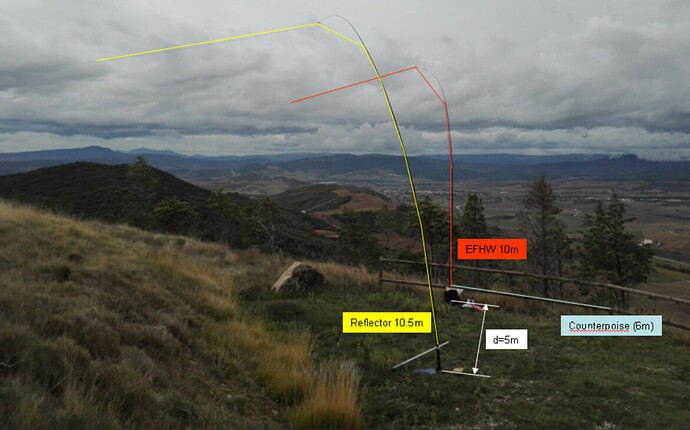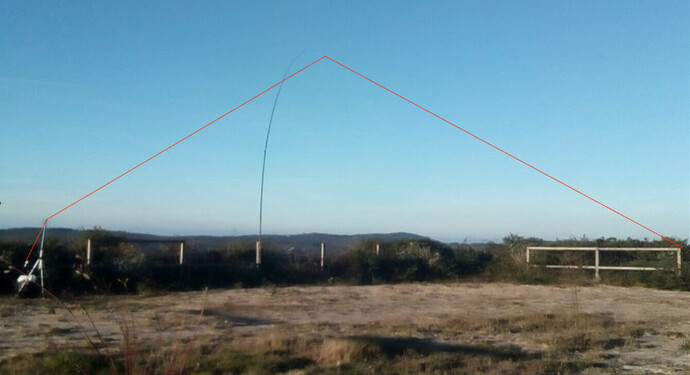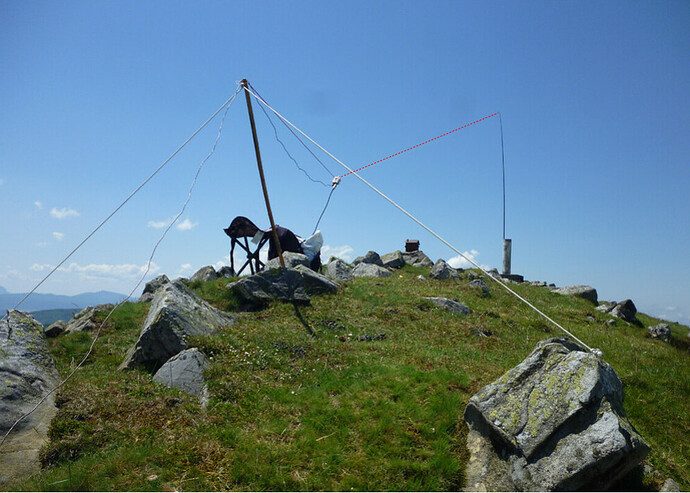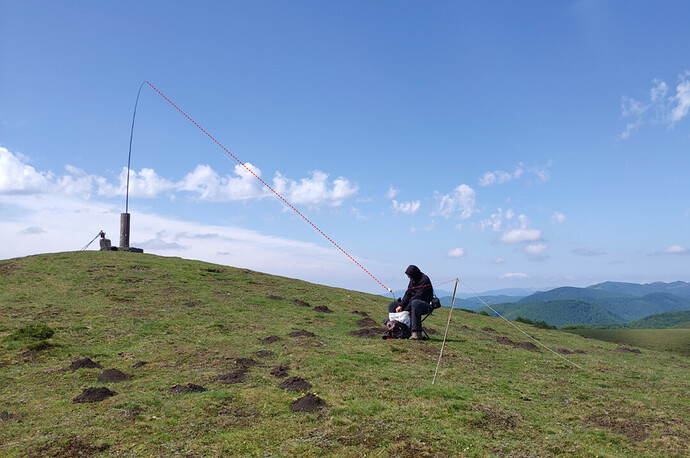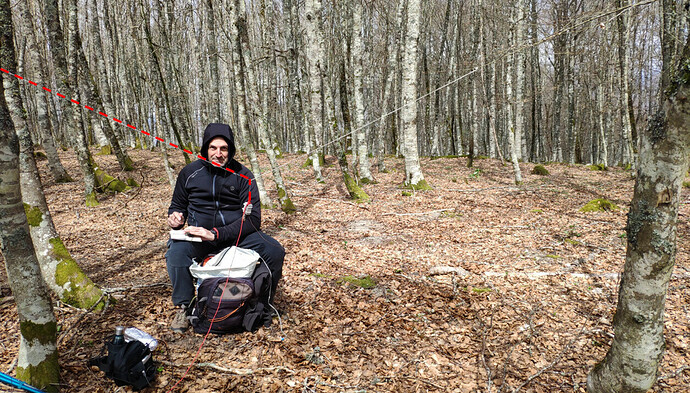Interesting, that would get me on additional bands. Great, something else I have to buy! And put together!!
Hi Brent,
Most of the times I activate with an endfed wire to a 9:1 unun and a counterpoise wire.
Some few times I’ve setup as inverted L with even an inverted L reflector.
Some few times I’ve setup as inverted vee:
and most of the times I setup as a sloper like this when there are no branches around:
and like this when there are:
The PAR is kinda heavy. I use a home made efhw using #28 teflon wire. If you make the wire 68 feet long, then attach a two foot stub hanging down right in the center of the wire, you can adjust the length of that stub (will be about 18 inches) for resonance on 20M, and do away with the heavy trap. The stub will be ignored on 40. Have never had any trouble mounting wire inverted-L and then leaning pole against anything, or bracing it in a pile of rocks. EZ. As for five watts, that’s fine. Can work world wide with five watts and an EFHW on CW if band is open. GL 73, Fred KT5X / WS0TA
First off, you can make the same antenna much lighter. I have been using #28 teflon wire for years without failure. Make the wire 68 feet long and resonate for 40M. Hang a 24 inch stub from the exact middle of the wire, and trim it for resonance on 20M. 40M signal will ignore the stub. 20M needs the stub because it is a fullwave with only two ends, so the end-effect shortening doesn’t apply to one of the halfwaves. Next comment, a pole with carbon in it will detune the wire a little IF the wire runs very close to the pole, but no evidence it diminishes signal radiated. Wire does NOT need to be high when on a mountain peak with the ground sloping steeply away from the antenna. Antenna likely thinks it is very high. I skip coax entirely. It is heavy (forces a heavier than needed pole to support it), cumbersome, and may contribute some loss. Since I am located at the end of the antenna, and the end of an EFHW has no current, I just plug it in directly using the first few feet of the wire as the feedline. An inverted-L configuration puts some of the radiation on the top of the vertical leg, for low angle take-off angle. My antenna weighs two ounces including the winder. My pole weighs 8 ounces, is 17 feet tall, and collapses to 18 inches. Set up time is five minutes or less. Five watts with decent conditions can be heard around the globe. GL 73, Fred KT5X / WS0TA
I have linked dipoles [60/40/30/20 and 20/10/6] and EFHWs [40/30/20 and 40/20/10]. For everyday [i.e. non big event] HF activations, if I’m not using my new Chameleon MPAS Lite vertical, I usually take an EFHW.
I do not favour the situation where the wire antenna itself is acting as 1 or 2 of the pole guying ‘cords’. Despite having more benign weather than many parts of the world, the regions I operate mostly from [in north-west England and SW Scotland] often have strong and blustery winds especially in winter. I found it stresses my thin-wire antennas at the connection to the balun and links.
So, nowadays I use 3 or 4 guying cords for the pole which means I can ensure the antenna wire has a bit of slack in it. I’ve had no problems after many activations since. The extra weight / volume is nothing and – in very strong wind – it can actually be quicker to erect the pole and tether the end(s) of the antenna separately.
I always use 10m of RG174 coax feeder. The pole or far end(s) of the antenna are rarely somewhere I want to sit. The feeder gives me some flexibility as to where to operate especially in winter. I want to sit in some leeward shelter from the icy wind even if that’s in the heather. The RG174 attenuation is small at HF and is small and lightweight.
73 Andy
Love this discussion, great insights from all, thanks
73 de Geoff vk3sq
Now that field day is over and I have caught up on work: thank you all. There is a tremendous amount of experience here and it is very helpful for me and I am sure others.
There are some future projects I have added to the list and, more immediately, some antenna, cable, and set up work I need to do over the next couple weeks before my trip.
I tried the Par trail friendly end fed at the park to cut to frequency and try to contact some activators. No good. The instructions say to adjust for 40 and 20 would fall into the correct frequency. I could get 40 but never remotely close on 20. I changed from an inverted L to a V and saw a significant disparity so SWR was unworkable. Same problem with 20 after adjusting 40.
Fred was correct, the trap is too heavy. And clearly the 20 section is too long or there is a problem with the winding. An antenna where the frequency shifts so drastically based on common configurations is unworkable for SOTA. I know some people use them but this one will not. In any event, I don’t have time to make my own before the trip so will only have 20 and maybe 15. I wanted 40 for closer chasers and early/late activations but maybe next time.
Brent,
This might help and only requires some wire and 3/4 inch pvc pipe (approx 1"OD).
Remove the radiator it came with and cut a new one for 20M and tune it. Then use about 3 inches of the pvc pipe and wind a coil using enamel wire (22 - 26 gauge) for 50 closely spaced turns. Attach one end to the 20M radiator and the other to about 7-8 feet of wire and tune for 40M.
I have made a few of these and they work well and end up at about 40 feet long. Yes, 40M is a bit narrow but you can tune for your preferred section of the band.
NOTE: This is not my design, it was shown on the PAKTENNA website - they deserve the thanks for this.
Hope this is doable for you Brent and if so that it works as well for you as it did me!
73,
Howard KE6MAK
Love the idea of rubber bands to hold the guy wires. So simple and effective.
Fred. What pole do you use? Thanks
